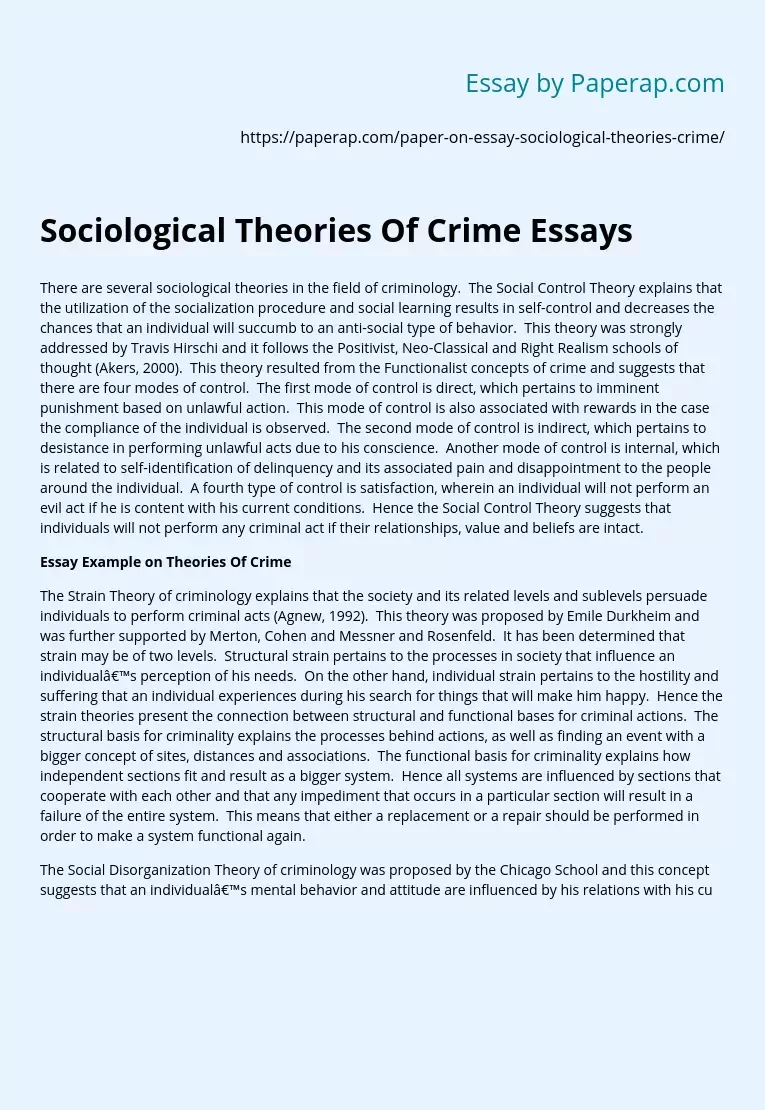Sociological Theories Of Crime Essays
There are several sociological theories in the field of criminology. The Social Control Theory explains that the utilization of the socialization procedure and social learning results in self-control and decreases the chances that an individual will succumb to an anti-social type of behavior. This theory was strongly addressed by Travis Hirschi and it follows the Positivist, Neo-Classical and Right Realism schools of thought (Akers, 2000). This theory resulted from the Functionalist concepts of crime and suggests that there are four modes of control.
The first mode of control is direct, which pertains to imminent punishment based on unlawful action. This mode of control is also associated with rewards in the case the compliance of the individual is observed. The second mode of control is indirect, which pertains to desistance in performing unlawful acts due to his conscience. Another mode of control is internal, which is related to self-identification of delinquency and its associated pain and disappointment to the people around the individual.
A fourth type of control is satisfaction, wherein an individual will not perform an evil act if he is content with his current conditions. Hence the Social Control Theory suggests that individuals will not perform any criminal act if their relationships, value and beliefs are intact.
Essay Example on Theories Of Crime
The Strain Theory of criminology explains that the society and its related levels and sublevels persuade individuals to perform criminal acts (Agnew, 1992). This theory was proposed by Emile Durkheim and was further supported by Merton, Cohen and Messner and Rosenfeld.
It has been determined that strain may be of two levels. Structural strain pertains to the processes in society that influence an individual’s perception of his needs. On the other hand, individual strain pertains to the hostility and suffering that an individual experiences during his search for things that will make him happy. Hence the strain theories present the connection between structural and functional bases for criminal actions. The structural basis for criminality explains the processes behind actions, as well as finding an event with a bigger concept of sites, distances and associations. The functional basis for criminality explains how independent sections fit and result as a bigger system. Hence all systems are influenced by sections that cooperate with each other and that any impediment that occurs in a particular section will result in a failure of the entire system. This means that either a replacement or a repair should be performed in order to make a system functional again.
The Social Disorganization Theory of criminology was proposed by the Chicago School and this concept suggests that an individual’s mental behavior and attitude are influenced by his relations with his current situation or behavior (Burgess et al., 1964). This theory is based on the assumption that attitudes are not inherent but are generated from the course of acculturation. Each planned action is related to an individual’s social significance because it is linked to a situation in which the individual is has to react with and because it has been molded by the attitudes that were developed from a life time of social and cultural events. This concept is based on the four wishes theory which states that if individuals perceive situations as real, then the consequences are also real. The four wishes include wish for novel experiences, the longing for acknowledgment, the aspiration for domination, and the craving for security. The achievement of the four wishes will result in a particular attitude that is meaningful and worth sharing. Hence an individual’s new feelings and outlook in life result from the embodiment of specific experiences and individuals and events.
Sociological Theories Of Crime Essays. (2019, Nov 27). Retrieved from https://paperap.com/paper-on-essay-sociological-theories-crime/

